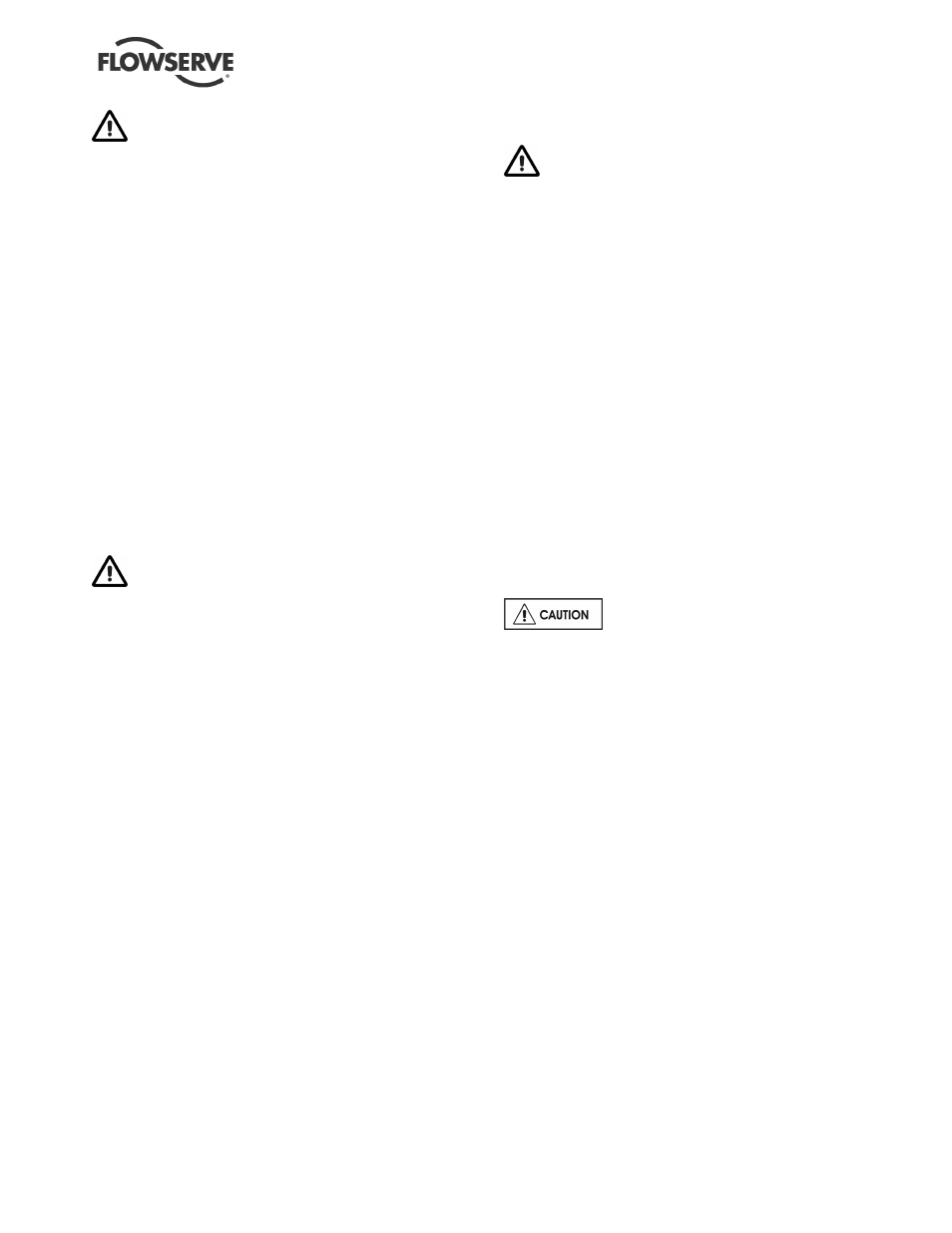Flowserve ESP3 User Manual
Page 19

ESP3 USER INSTRUCTIONS ENGLISH 26999943 08-11
Page 19 of 64
Failure to ensure that a seal is installed may
result in serious leakage of vapor and of the pumped
fluid.
Seal and seal support system must be installed and
operational as specified by the seal manufacturer.
The stuffing box/seal chamber/gland may have
ports that have been temporarily plugged at the
factory to keep out foreign matter. It is the
installer’s responsibility to determine if these plugs
should be removed and external piping connected.
Refer to the seal drawings and or the local
Flowserve representative for the proper
connections.
4.5.2 Packing
When the pump is intended to be equipped with
shaft packing, it is NOT Flowserve standard
practice to install the packing in the stuffing box
prior to shipment. The packing is shipped with the
pump. It is the pump installer’s responsibility to
install the packing in the stuffing box. Installation
instructions can be found in section 6.
Failure to ensure that the packing is installed
may result in serious leakage of vapor and of the
pumped fluid.
4.6 Driver Mounting
a)
Before the motor is installed, be sure to
connect the motor half coupling hub and the
pump half coupling hub onto their respective
shafts.
b)
Carefully lift the motor and place it on the
support head [3160] of the pump.
c)
Turn the motor frame to one of the four
positions where the motor bolt holes line up to
the support head [3160]. Select the position of
the motor to suit the desired conduit box
location. Install the motor hold down bolts
[6570.1]. In some instances a motor adapter
[1340.3] may be furnished. In this case the
adapter must be installed before the motor can
be mounted.
d)
Motor to pump alignment is controlled by fits
within the adapter and cannot be adjusted.
e)
Locate the coupling and source of electrical
power but DO NOT INSTALL THE COUPLING
DRIVE ELEMENT AT THIS TIME.
f)
Connect the motor terminals to the leads from
the starter panel. Make sure the motor shaft
and/or coupling is not touching any part of the
pump shaft or pump half coupling. Rotate the
motor shaft by hand to make sure it is free to
rotate when energized.
Never check driver rotation unless the
pump and driver shafts are disconnected and
physically separated. Failure to follow this
instruction can result in serious damage to the
pump and driver if rotation is in the wrong
direction.
g)
Jog the motor and check for proper rotation
which should be clockwise when looking
down on top of the motor. If rotation is wrong,
interchange any two motor connections on
three-phase motors. On single-phase motors,
follow the motor manufacturer’s instructions. After
changing the connections, again check the rotation
to ensure that the direction is correct.
h)
Disconnect and lockout the power supply to the
driver.
i)
The coupling can now be fully installed and
join the driver and pump shafts together (see
section 5.4.2).
j)
Install the coupling guarding [7450.1-.2] (see
section 5.5).
4.7 Piping
Protective covers are fitted to both the
suction and discharge flanges of the casing and must
be removed prior to connecting the pump to any
pipes.
4.7.1 General piping
If the pump flange(s) have tapped holes, select flange
fasteners with thread engagement at least equal to
the fastener diameter but that do not bottom out in the
tapped holes before the joint is tight.
4.7.2 Suction piping
ESP pumps typically only have strainers attached to
the suction flange of the pump casing. An option for
an extension from the suction flange is available and
is called a tailpipe (see section 8 for cross-sectional
drawing). A tailpipe is useful for applications where
there is adequate NPSH at the lowest sump level but
the discharge pressure is critical and must be
maintained at a maximum value compared to using a
longer column and shaft. Pumps may air-bind if air is
allowed to leak into the piping
